Water Resources Response to Changes in Temperature, Rainfall and CO2 Concentration: A First Approach in NW Spain
Abstract
:1. Introduction
2. Materials and Methods
2.1. Description of the Study Area
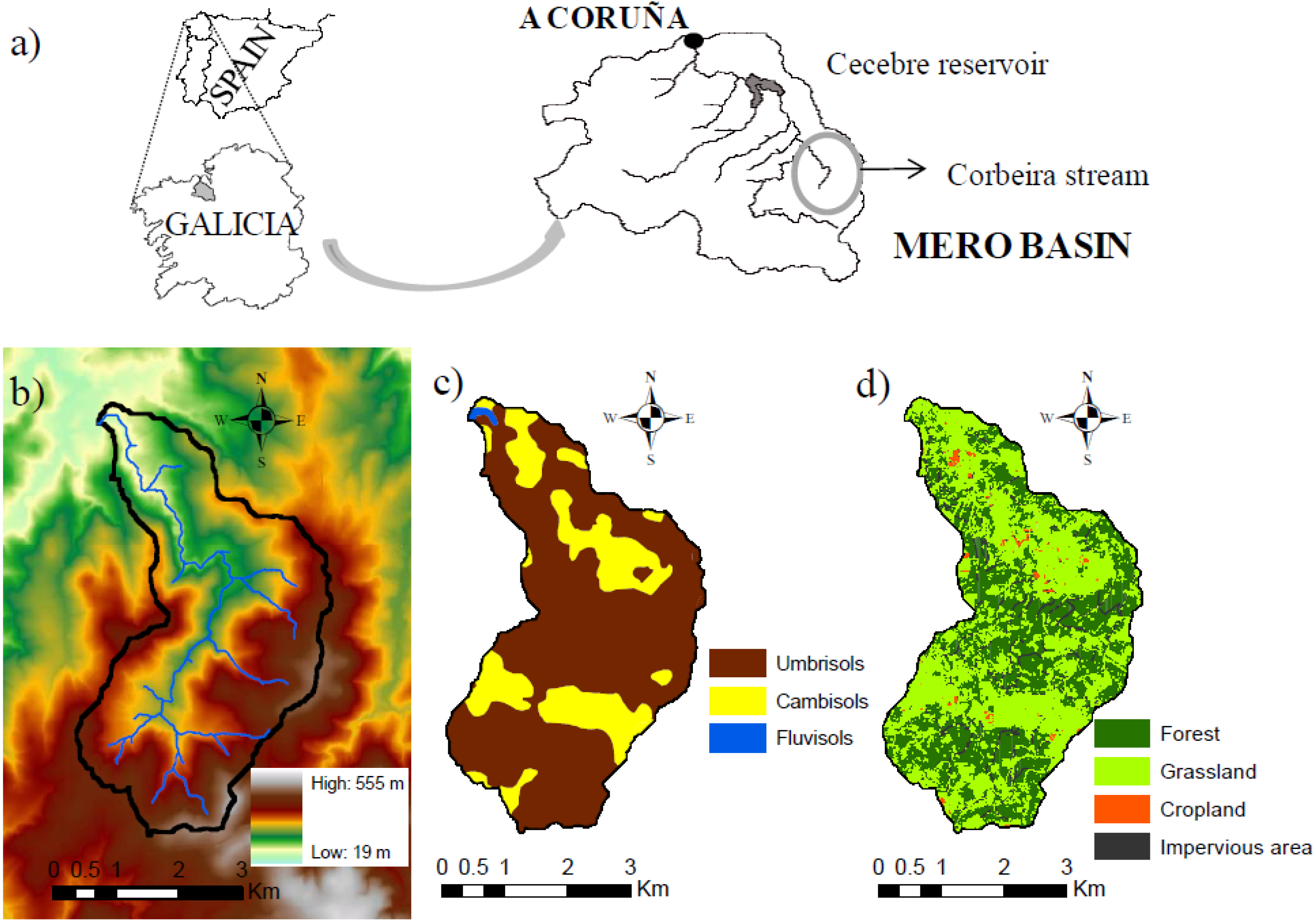
2.2. Data and Model Setup
2.2.1. The SWAT Hydrological Model
2.2.2. Model Inputs
2.2.3. Calibration, Validation and Evaluation of the Model
| Parameter | Calibration | Validation |
|---|---|---|
| R2 | 0.80 | 0.84 |
| PBIAS | −1.8 | −3.3 |
| NSE | 0.80 | 0.83 |
| Observed mean and range (m3 s−1) | 0.18 (0.02–1.42) | 0.24 (0.02–1.20) |
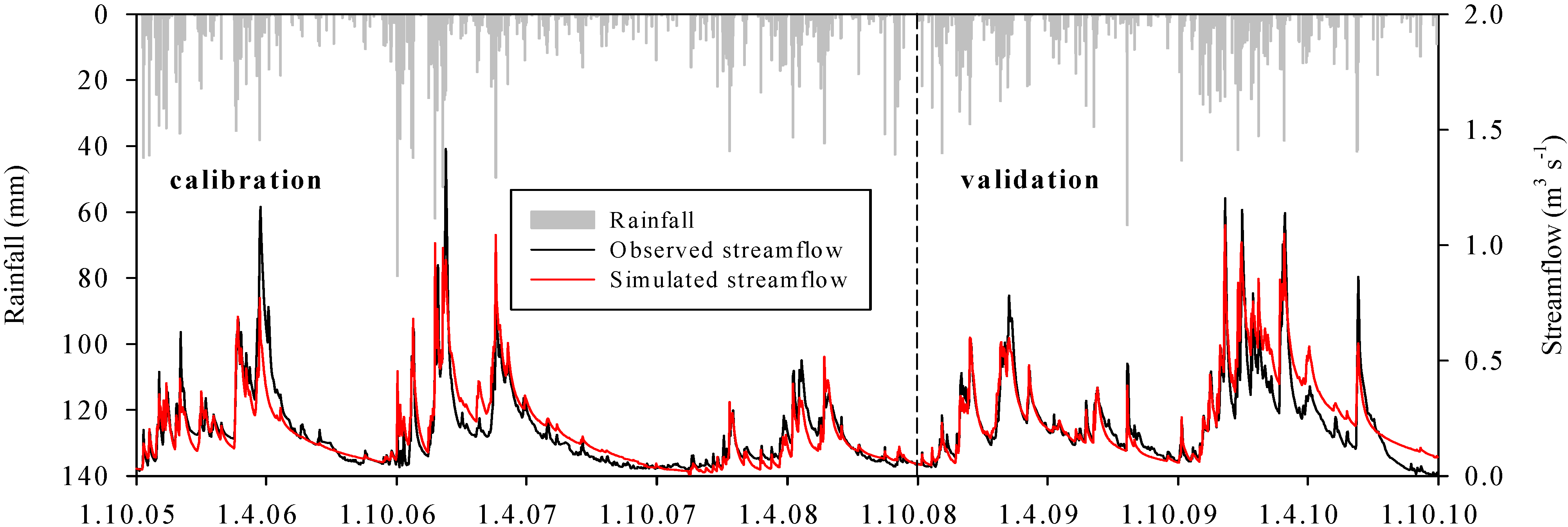
2.3. Scenarios of Temperature, Rainfall and CO2 Concentration Changes
| Name | Institute | GCM | RCM | Time Period |
|---|---|---|---|---|
| C4IRCA3 | C4I (1) | HadCM3Q16 | RCA3 | 1951–2099 |
| CNRM/RM5.1 | CNRM (2) | ARPEGE RM5.1 | Aladin | 1950–2100 |
| DMI/ARPEGE | DMI (3) | ARPEGE | HIRHAM | 1951–2100 |
| DMI/BCM DMI | DMI (3) | BCM | DMI-HIRHAM5 | 1961–2098 |
| DMI/ECHAM5-r3 | DMI (3) | ECHAM5-r3 | DMI-HIRHAM5 | 1951–2099 |
| ETHZ/CLM | ETHZ (4) | HadCM3Q0 | CLM | 1951–2099 |
| ICTP/RegCM3 | ICTP (5) | ECHAM5-r3 | RegCM3 | 1951–2100 |
| KNMI/RACMO2 | KNMI (6) | ECHAM5-r3 | RACMO | 1950–2100 |
| MPIM/REMO | MPI (7) | ECHAM5-r3 | REMO | 1951–2100 |
| SMHI/BCM | SMHI (8) | BCM | RCA | 1961–2100 |
| SMHI/ECHAM5-r3 | SMHI (8) | ECHAM5-r3 | RCA | 1951–2100 |
| SMHI/HadCM3Q3 | SMHI (8) | HadCM3Q3 | RCA | 1951–2100 |
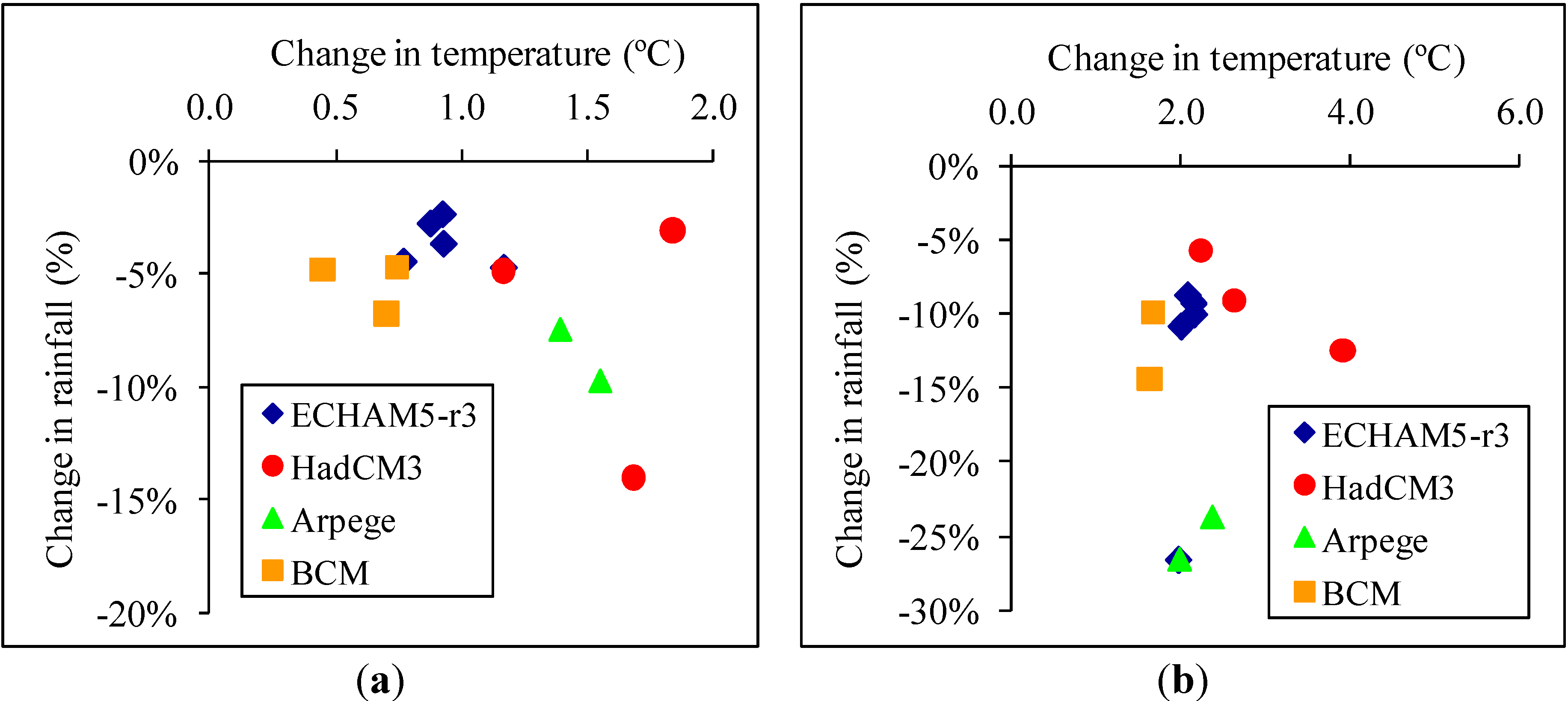
| Scenario | Temperature (°C) | Rainfall (%) | CO2 Concentration (ppm) |
|---|---|---|---|
| 1 | 1.1 (mean 2031–2060) | 0 | 330 |
| 2 | 1.7 (maximum 2031–2060) | 0 | 330 |
| 3 | 2.2 (mean 2069–2098) | 0 | 330 |
| 4 | 3.9 (maximum 2069–2098) | 0 | 330 |
| 5 | 0 | −6 (mean 2031–2060) | 330 |
| 6 | 0 | −14 (maximum 2031–2060) | 330 |
| 7 | 0 | −15 (mean 2069–2098) | 330 |
| 8 | 0 | −27 (maximum 2069–2098) | 330 |
| 9 | 0 | 0 | 550 |
| 10 | 0 | 0 | 660 |
| 11 | 1.1 | −6 | 550 |
| 12 | 1.7 | −14 | 550 |
| 13 | 2.2 | −15 | 660 |
| 14 | 3.9 | −27 | 660 |
| 15 | 1.1 | −6 | 330 |
| 16 | 2.2 | −15 | 330 |
3. Results and Discussion
3.1. Vulnerability of Streamflow to Change in Temperature, Rainfall or CO2 Concentration
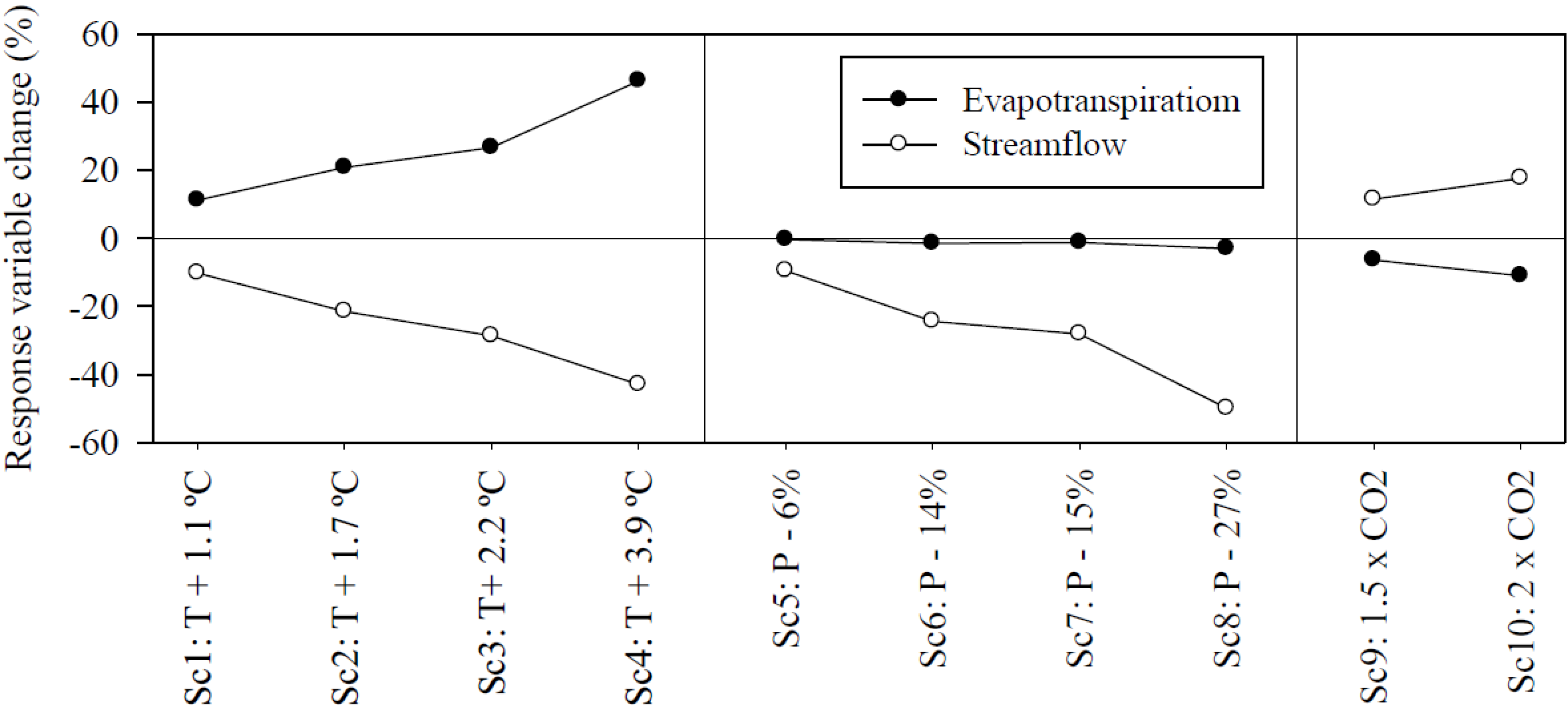
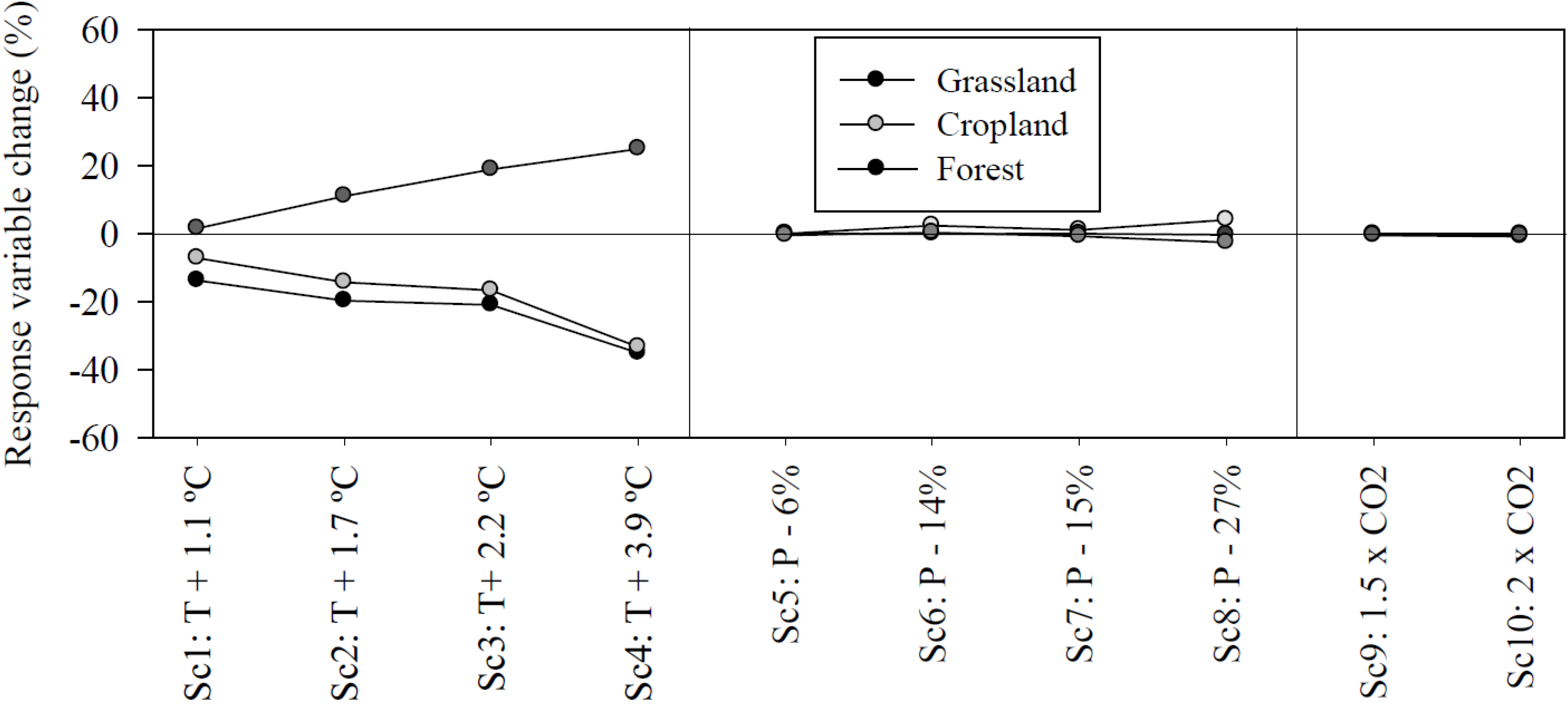
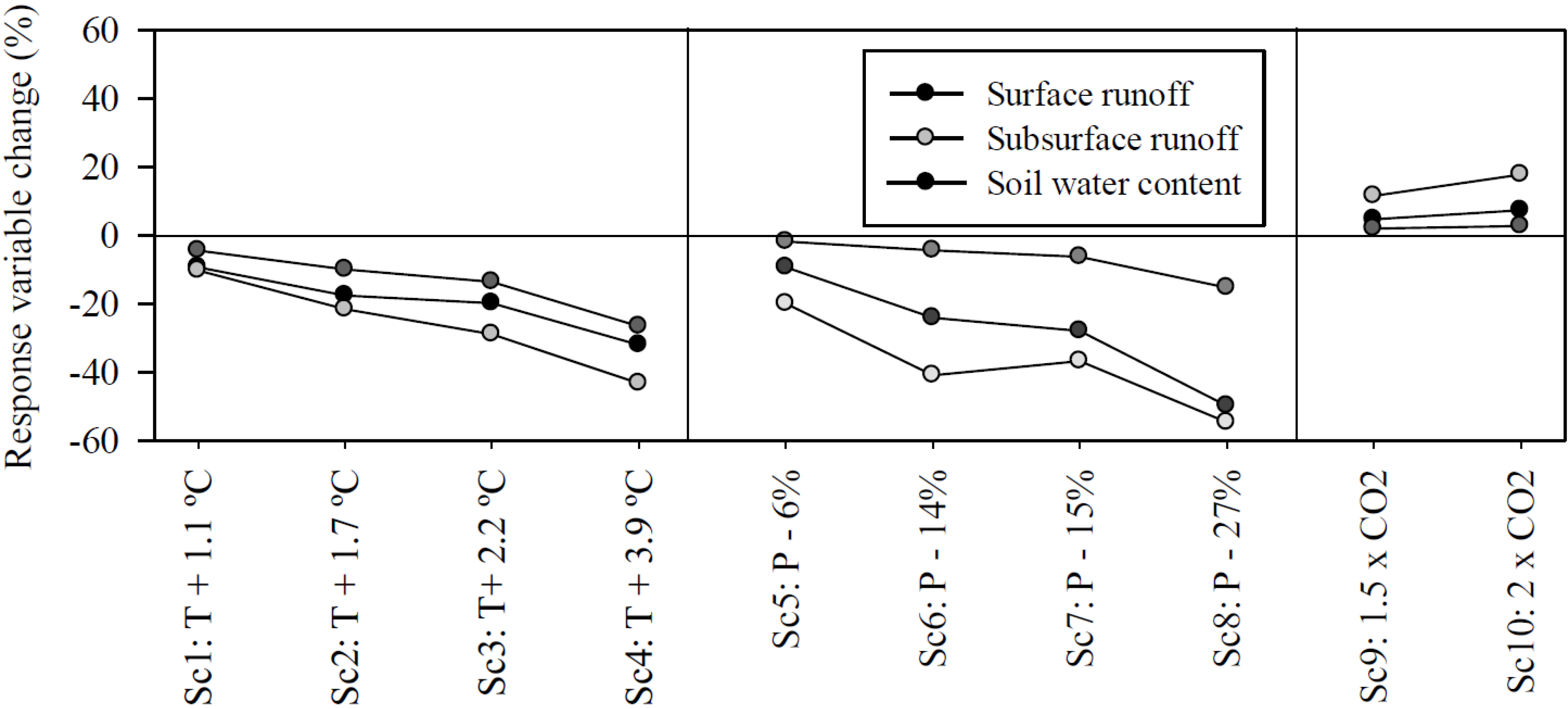
3.2. Vulnerability of Streamflow to Simultaneous Changes in Climate Parameters

4. Conclusions
Acknowledgments
Author Contributions
Conflicts of Interest
References
- Intergovernmental Panel on Climate Change (IPCC). Impacts, Adaptation, and Vulnerability; Part A: Global and Sectoral Aspects. Contribution of Working Group II to the Fifth Assessment Report of the Intergovernmental Panel on Climate Change; Field, C.B., Barros, V.R., Dokken, D.J., Mach, K.J., Mastrandrea, M.D., Bilir, T.E., Chatterjee, M., Ebi, K.L., Estrada, Y.O., et al., Eds.; Cambridge University Press: Cambridge, UK; New York, NY, USA, 2014. [Google Scholar]
- Van der Linden, P.; Mitchell, J.F.B. ENSEMBLES: Climate Change and its Impacts: Summary of Research and Results from the ENSEMBLES Project; Met Office Hadley Centre: Exeter, UK, 2009; p. 160. [Google Scholar]
- Houghton, J.T.; Ding, Y.; Griggs, D.J.; Noguer, M.; van der Linden, P.J.; Dai, X.; Maskell, K.; Johnson, C.A. Climate Change: The Scientific Basis. In Contribution of Working Group I to the Third Assessment Report of the Intergovernmental Panel on Climate Change; Cambridge University Press: Cambridge, United Kingdom and New York, NY, USA, 2001; p. 881. [Google Scholar]
- Lehner, B.; Doll, P.; Alcamo, J.; Henrichs, T.; Kaspar, F. Estimating the impact of global change on flood and drought risks in Europe: A continental integrated analysis. Clim. Chang. 2006, 75, 273–299. [Google Scholar]
- Kundzewics, Z.; Mata, L.; Arnell, N.; Döll, P.; Jimenez, B.; Miller, K.; Oki, T.; Sen, Z.; Shiklomanov, I. The implications of projected climate change for freshwater resources and their management. Hydrolog. Sci. J. 2008, 53, 3–10. [Google Scholar]
- Pruski, F.F.; Nearing, M.A. Climate-induced changes in erosion during the 21st century for eight U.S. locations. Water Resour. Res. 2002, 38, 34-1–34-12. [Google Scholar]
- Zabaleta, A.; Meaurio, M.; Ruiz, E.; Antigüedad, I. Simulation climate change impact on runoff and sediment yield in a small watershed in the Basque Country, northern Spain. J. Environ. Qual. 2013, 43, 235–245. [Google Scholar]
- Chaplot, V. Water and soil resources response to rising levels of atmospheric CO2 concentration and to changes in precipitation and air temperature. J. Hydrol. 2007, 337, 159–171. [Google Scholar]
- Butcher, J.P.; Johnson, T.E.; Nover, D.; Sarkar, S. Incorporating the effects of increased atmospheric CO2 in watershed model projections of climate change impacts. J. Hydrol. 2014, 513, 322–334. [Google Scholar]
- López-Moreno, J.I.; Goyette, S.; Beniston, M. Climate change prediction over complex areas: Spatial variability of uncertainties and expected changes over the Pyrenees from a set of regional climate models. Int. J. Climatol. 2008, 28, 1535–1550. [Google Scholar]
- Nunes, J.P.; Seixas, J.; Pacheco, N.R. Vulnerability of water resources, vegetation productivity and soil erosion to climate change in Mediterranean watersheds. Hydrol. Process. 2008, 22, 3115–3134. [Google Scholar]
- Estrela, T.; Pérez-Martin, M.A.; Vargas, E. Impacts of climate change on water resources in Spain. Hydrolog. Sci. J. 2012, 57, 1154–1167. [Google Scholar]
- Raposo, J.R.; Dafonte, J.; Molinero, J. Assessing the impact of future climate change on groundwater recharge in Galicia-Costa, Spain. Hydrogeol. J. 2013, 21, 459–479. [Google Scholar]
- García Ruiz, J.M.; López-Moreno, J.I.; Vicente-Serrano, S.M.; Lasanta-Martínez, T.; Beguería, S. Mediterranean water resources in a global change scenario. Earth Sci. Rev. 2011, 105, 121–139. [Google Scholar]
- Taboada, J.J. Riesgos asociados a fenómenos meteorológicos extremos. In Riesgos Naturales en Galicia. El Encuentro Entre Naturaleza y Sociedad; Fra-Paleo, U., Ed.; Universidad de Santiago de Compostela, Servicio de Publicaciones e Intercambio Científico: Santiago de Compostela, Spain, 2010; pp. 25–45. [Google Scholar]
- Gassman, P.W.; Reyes, M.R.; Green, C.H.; Arnold, J.G. The Soil and Water Assessment Tool: Historical development, applications, and future research directions. Trans. ASABE 2007, 50, 1211–1250. [Google Scholar]
- Wu, Y.; Liu, S.; Gallant, A.L. Predicting impacts of increased CO2 and climate change on the water cycle and water quality in the semiarid James River Basin of the Midwestern USA. Sci. Total Environ. 2012, 430, 150–160. [Google Scholar]
- Food and Agriculture Organization (FAO). World Reference Base for Soil Resources; World Soil Resources Reports 106; FAO: Rome, Italy, 2014. [Google Scholar]
- Instituto Tecnológico Geominero de España (IGME). Mapa Geológico de España, 1:50000. Hoja 45. Betanzos; Servicio de Publicaciones del Ministerio de Industria y Energía: Madrid, Spain, 1981. [Google Scholar]
- Arnold, J.G.; Srinivasan, R.; Muttiah, R.S.; Williams, J.R. Large area hydrologic modeling and assessment part I: Model development. J. Am. Water Res. Assoc. 1998, 34, 73–89. [Google Scholar]
- Neitsch, S.L.; Arnold, J.G.; Srinivasan, R.; Williams, J.R. Soil and Water Assessment Tool User´s Manual; Texas Water Resources Institute: Collegue Station, TX, USA, 2002; p. 506. [Google Scholar]
- Green, C.; van Griensven, A. Autocalibration in hydrologic modeling: Using SWAT 2005 in small-scale watersheds. Environ. Model. Softw. 2008, 23, 422–434. [Google Scholar]
- Easterling, W.E.; Rosenberg, N.J.; McKenney, M.S.; Jones, C.A.; Dyke, P.T.; Williams, J.R. Preparing the erosion productivity impact calculator (EPIC) model to simulate crop response to climate change and the direct effects of CO2. Agric. For. Meteorol. 1992, 59, 17–34. [Google Scholar]
- Stockle, C.O.; Williams, J.R.; Rosenberg, N.J.; Jones, C.A. A method for estimating the direct and climatic effects of rising atmospheric carbon dioxide on growth and yield of crops: Part 1—Modification of the EPIC model for climate change analysis. Agric. Syst. 1992, 38, 225–238. [Google Scholar]
- Martínez-Cortizas, A.; Castillo-Rodríguez, F.; Pérez-Alberti, A. Factores que intervienen en la precipitación y el balance de agua en Galicia. Bol. Asoc. Geógr. Esp. 1994, 18, 79–96. [Google Scholar]
- Taboada-Castro, M.M.; Lado-Liñares, M.; Diéguez, A.; Paz, A. Evolución temporal de la infiltración superficial a escala de parcela. In Avances Sobre el Estudio de la Erosión Hídrica; Paz, A., Taboada, M.T., Eds.; Universidade da Coruña: A Coruña, Spain, 1999; pp. 101–127. [Google Scholar]
- Saxton, K.E.; Rawls, W.J.; Romberger, J.S.; Papendick, R.L. Estimating generalized soil-water characteristics from texture. Soil Sci. Soc. Am. J. 1986, 50, 1031–1036. [Google Scholar]
- Ferrer Julià, M.; Estrela, M.T.; Sánchez, J.A.; García, M. Constructing a saturated hydraulic conductivity map of Spain using pedotransfer functions and spatial prediction. Geoderma 2004, 123, 257–277. [Google Scholar]
- Rodríguez-Suárez, J.A.; Soto, B.; Iglesias, M.L.; Díaz-Fierros, F. Application of the 3PG forest growth model to a Eucalyptus globulus plantation in Northwest Spain. Eur. J. For. Res. 2010, 129, 573–583. [Google Scholar]
- Arnold, J.G.; Allen, P.M.; Muttiah, R.; Bernhardt, G. Automated base flow separation and recession analysis techniques. Ground Water 1995, 33, 1010–1018. [Google Scholar]
- Motovilov, Y.; Gottschalk, G.L.; Engeland, K.; Rodhe, A. Validation of distributed hydrological model against spatial observations. Agri. For. Meteorol. 1999, 98, 257–277. [Google Scholar]
- Moriasi, D.N.; Arnold, J.G.; van Liew, M.W.; Bingner, R.L.; Harmel, R.D.; Veith, T.L. Model evaluation guidelines for systematic quantification of accuracy in watershed simulations. Transl. ASABE 2007, 50, 885–900. [Google Scholar]
- Rodríguez-Blanco, M.L.; Taboada-Castro, M.M.; Taboada-Castro, M.T. Rainfall runoff response and event-based runoff coefficients in a humid area (northwest Spain). Hydrolog. Sci. J. 2012, 57, 445–459. [Google Scholar]
- Palleiro, L.; Rodríguez-Blanco, M.L.; Taboada-Castro, M.M.; Taboada-Castro, M.T. Hydroclimatic response of a humid agroforestry catchment at different times scales. Hydrol. Process 2014, 28, 1677–1688. [Google Scholar]
- Benaman, J.; Shoemaker, C.A.; Haith, D.A. Calibration and validation of soil and water assessment tool on an agricultural watershed in upstate New York. J. Hydrol. 2005, 10, 363–374. [Google Scholar]
- Kirchner, J.W. Getting the right answers for the right reasons: Linking measurements, analyses, and models to advance the science of hydrology. Water Resour. Res. 2006, 42. [Google Scholar] [CrossRef]
- Zhang, X.; Xu, Y.P.; Fu, G. Uncertainties in SWAT extreme flow simulation under climate change. J. Hydrol. 2014, 515, 205–222. [Google Scholar]
- Winkler, J.A.; Guentchev, G.S.; Perdinan; Tan, P.N.; Zhong, S.; Liszewska, M.; Abraham, Z.; Niedzwiedz, T.; Ustrnul, Z. Climate scenario development and applications for local/regional climate change impact assessments: An overview for the non-climate scientist. Part I: Scenario development using downscaling methods. Geogr. Compass 2011, 5, 275–300. [Google Scholar]
- Fowler, H.J.S.; Blenkinsop, S.; Tebaldi, C. Linking climate change modelling to impacts studies: Recent advances in downscaling techniques for hydrological modelling. Int. J. Climatol. 2007, 27, 1547–1578. [Google Scholar]
- Sharpley, A.N.; Williams, J.R. EPIC-Erosion Productivity Impact Calculator, I. Model Documentation; U.S. Department of Agriculture, Agricultural Research Service: Washington, DC, USA, 1990; p. 235. [Google Scholar]
- Ficklin, D.L.; Luo, Y.; Luedeling, E.; Zhang, M. Climate change sensitivity assessment of a highly agricultural watershed using SWAT model. J. Hydrol. 2009, 374, 16–29. [Google Scholar]
- Zhang, H.; Huang, G.H.; Wang, D.; Zhang, X. Uncertainty assessment of climate change impacts on the hydrology of small prairie wetlands. J. Hydrol. 2011, 396, 94–103. [Google Scholar]
- Pruski, F.F.; Nearing, M.A. Runoff and soil-loss responses to changes in precipitation: A computer simulation study. J. Soil Water Conserv. 2002, 57, 7–16. [Google Scholar]
- Rosenzweig, C.; Hillel, D. Climate Change and the Global Harvest. Potential Impacts of the Greenhouse Effect on Agriculture; Oxford University Press: New York, NY, USA, 1998; p. 324. [Google Scholar]
- Katul, G.; Manzoni, S.; Palmroth, S.; Oren, R. A stomatal optimization theory to describe the effects of atmospheric CO2 on leaf photosynthesis and transpiration. Ann. Bot. 2009, 105, 431–442. [Google Scholar]
- Bunce, J.A. Carbon dioxide effects on stomatal responses to the environment and water use by crops under field conditions. Oecologia 2004, 140, 1–10. [Google Scholar]
- Beguería, S.; López-Moreno, J.I.; Lorente, A.; Seeger, M.; García-Ruiz, J.M. Assessing the effect of climate change and land-use changes on streamflow in the central Spanish Pyrenees. Ambio 2003, 32, 283–286. [Google Scholar]
- Hamilton, E.W.; Heckathorn, S.A.; Joshi, P.; Wang, D.; Barua, D. Interactive effects of elevated CO2 and growth temperature on the tolerance of photosynthesis to acute heat stress in C3 and C4 species. J. Integr. Plant Biol. 2008, 50, 1375–1387. [Google Scholar]
© 2014 by the authors; licensee MDPI, Basel, Switzerland. This article is an open access article distributed under the terms and conditions of the Creative Commons Attribution license (http://creativecommons.org/licenses/by/4.0/).
Share and Cite
Arias, R.; Rodríguez-Blanco, M.L.; Taboada-Castro, M.M.; Nunes, J.P.; Keizer, J.J.; Taboada-Castro, M.T. Water Resources Response to Changes in Temperature, Rainfall and CO2 Concentration: A First Approach in NW Spain. Water 2014, 6, 3049-3067. https://doi.org/10.3390/w6103049
Arias R, Rodríguez-Blanco ML, Taboada-Castro MM, Nunes JP, Keizer JJ, Taboada-Castro MT. Water Resources Response to Changes in Temperature, Rainfall and CO2 Concentration: A First Approach in NW Spain. Water. 2014; 6(10):3049-3067. https://doi.org/10.3390/w6103049
Chicago/Turabian StyleArias, Ricardo, M. Luz Rodríguez-Blanco, M. Mercedes Taboada-Castro, Joao Pedro Nunes, Jan Jacob Keizer, and M. Teresa Taboada-Castro. 2014. "Water Resources Response to Changes in Temperature, Rainfall and CO2 Concentration: A First Approach in NW Spain" Water 6, no. 10: 3049-3067. https://doi.org/10.3390/w6103049
APA StyleArias, R., Rodríguez-Blanco, M. L., Taboada-Castro, M. M., Nunes, J. P., Keizer, J. J., & Taboada-Castro, M. T. (2014). Water Resources Response to Changes in Temperature, Rainfall and CO2 Concentration: A First Approach in NW Spain. Water, 6(10), 3049-3067. https://doi.org/10.3390/w6103049





